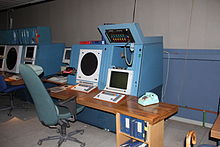- Command center
-
"War room" redirects here. For the film, see The War Room. For the fictional location in the Power Rangers series, see Power Chamber.
A command center (often called a war room) is any place that is used to provide centralized command for some purpose.
While frequently considered to be a military facility, these can be used in many other cases by governments or businesses. The term "war room" is also often used in politics to refer to teams of communications people who monitor and listen to the media and the public, respond to inquiries, and synthesize opinions to determine the best course of action.
Contents
Military and government
A command center is a central place for carrying out orders and for supervising tasks, also known as a headquarters, or HQ.
Common to every command center are three general activities: inputs, processes and outputs. The inbound aspect is communications (usually intelligence and other field reports). Inbound elements are "sitreps" (situation reports of what is happening) and "progreps" (progress reports relative to a goal which has been set) from the field back to the command element.
The process aspect involves a command element that makes decisions about what should be done about the input data. In the US military the command consists of a field- (Major to Colonel) or flag- (General) grade commissioned officer with one or more advisers. The outbound communications then delivers command decisions (i.e. operating orders) to the field elements.
Command centers should not be confused with the high-level military formation of a Command - as with any formation, Commands may be controlled from a command center, however not all formations controlled from a command centre are Commands.
Examples
Canada
During the Cold War, the Government of Canada undertook the construction of "Emergency Government Headquarters", to be used in the event of nuclear warfare or other large-scale disaster. Canada was generally allied with the United States for the duration of the war, was a founding member of NATO, allowed American cruise missiles to be tested in the far north, and flew sovereignty missions in the Arctic.
For these reasons, the country was often seen as being a potential target of the Soviets at the height of nuclear tensions in the 1960s. Extensive post-attack plans were drawn up for use in emergencies, and fallout shelters were built all across the country for use as command centres for governments of all levels, the Canadian Forces, and rescue personnel, such as fire services.
Different levels of command centres included:
- CEGF, Central Emergency Government Facility, located in Carp, Ontario, near the National Capital Region. Designed for use by senior federal politicians and civil servants.
- REGHQ, Regional Emergency Government Headquarters, of which there were seven, spread out across the country.
- MEGHQ, Municipal Emergency Government Headquarters
- ZEGHQ, Zone Emergency Government Headquarters, built within the basements of existing buildings, generally designed to hold around 70 staff.
- RU, Relocation Unit, or CRU, Central Relocation Unit. Often bunkers built as redundant backups to REGHQs and MEGHQs were given the RU designation.
United Kingdom
Constructed in 1938, the Cabinet War Rooms were used extensively by Sir Winston Churchill during the Second World War.
United States
A Command and Control Center is a specialized type of command center operated by a government or municipal agency 24 hours a day, 7 days a week. Various branches of the U.S Military such as the U.S Coast Guard and Navy have command and control centers.
They are also common in many large correctional facilities. A Command and Control Center operates as the agency's dispatch center, surveillance monitoring center, coordination office and alarm monitoring center all in one.
Command and control centers are not staffed by high level officials but rather by highly skilled technical staff. When a serious incident occurs the staff will notify the agency's higher level officials.
In Service Businesses
A command center enables the real-time visibility and management of an entire service operation. Similar to an air traffic control center, a command center allows organizations to view the status of global service calls, service technicians, and service parts on a single screen. In addition, customer commitments or service level agreements (SLAs) which have been made can also be programmed into the command center and monitored to ensure all are met and customers are satisfied.
A command Center is well suited for industries where coordinating field service (people, equipment, parts, and tools) is critical.
- Example: Intel's (TM) security Command Center
- Example: Dell's Enterprise Command Center
- Example: NASA's Mission Control Houston Command Center for Space Shuttle and ISS[1]
War Rooms can also be used for defining strategies, or driving business intelligence efforts[2]
In popular culture
The most famous war room in popular culture was the war room depicted in the 1964 film Dr. Strangelove, and seen later in other such movies, like Fail-Safe and WarGames.
See also
- Air traffic control
- Air Defense Control Center
- Combat Information Center
- Control center solutions
- C4ISTAR
- Dispatch
- Mission Control Center
- Network Operations Center
References
- ^ Mission Control Center
- ^ War Room - method and commonsense, by Yves-Michel Marti Egideria
Categories:- Aspects of organizations
- Corporate governance
- Military locations
- Command and control
- Nuclear command and control
- Military communications
Wikimedia Foundation. 2010.

